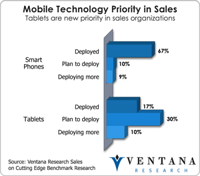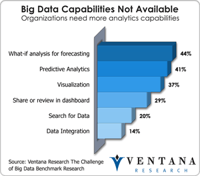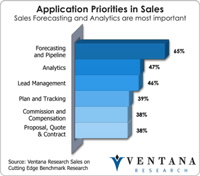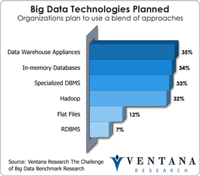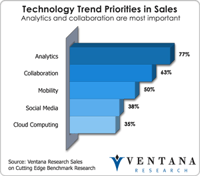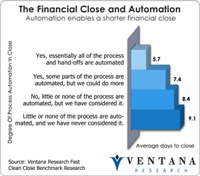I recently spoke with Oversight Systems, an operational intelligence analytics company that uses predictive analytics and optimization to help companies save money, reduce the risk of loss and fraud, and reinforce corporate governance and compliance efforts. Ventana Research views operational intelligence as an emerging technology with the potential for a high return on investment. By continuously monitoring activities in a company’s IT systems, Oversight’s Web-based software continuously,...
Read More
Topics:
Big Data,
Predictive Analytics,
Sales Performance,
Supply Chain Performance,
Fraud,
Governance,
GRC,
Office of Finance,
audit,
Operational Performance,
Analytics,
Business Analytics,
Business Performance,
Cloud Computing,
Financial Performance,
Governance, Risk & Compliance (GRC),
Information Management,
Operational Intelligence,
controls,
Oversight Systems
Our benchmark research into the contact center in the cloud shows that almost all companies now support multiple communication channels to engage with customers. Most of them also involve multiple business units in handling inbound and outbound interactions. More companies now support at-home agents, and contact centers are becoming more distributed. These scenarios are a good fit for cloud-based systems, and the research finds that the top three ways organizations said they can meet these...
Read More
Topics:
Predictive Analytics,
Sales Performance,
Customer Analytics,
Customer Experience,
Social CRM,
Speech Analytics,
Voice of the Customer,
Echopass,
Operational Performance,
Analytics,
Business Collaboration,
Business Intelligence,
Business Mobility,
Cloud Computing,
Customer & Contact Center,
Customer Service,
Information Applications,
Workforce Performance,
Call Center,
Contact Center,
Contact Center Analytics,
CRM,
Desktop Analytics,
Text Analytics,
Unified Communications
Acquisitions and new product releases continue to make the market for human capital management a hotbed of activity, as organizations attempt to fully utilize and increase the value of their workforces as I have outlined in my research agenda. ADP, with more than $10 billion in revenues and more than 570,000 customers, is aiming for the top spot in this market.
Read More
Topics:
Mobile,
Social Media,
HCM,
Human Capital Management,
Learning,
LMS,
Performance,
Operational Performance,
Business Analytics,
Business Performance,
Cloud Computing,
Financial Performance,
Workforce Performance,
Compensation,
HR,
TCM
I have commented before on the movement to adopt International Financial Reporting Standards (IFRS) by the United States to replace US-GAAP (Generally Accepted Accounting Principles). Most recently I discussed the drive toharmonize the significant differences between US-GAAP and IFRS on revenue recognition and lease accounting. To those who are interested in but not intimately involved with the subject, I suspect the current situation is a bit confusing, since there are multiple groups involved...
Read More
Topics:
Reporting,
audit,
Consolidation,
IFRS,
US-GAAP accounting,
XBRL,
Business Analytics,
Business Collaboration,
Business Performance,
Financial Performance,
Financial Management,
financial standards,
FPM
When the Salesforce.com marketing machine rolls into town, you have to sit up and listen, and that’s what 14,000 attendees did at the latest Cloudforce event in London. The company took over a vast portion of the ExCel London Exhibition Centre to accommodate the keynote speech, lots of side events and meeting rooms and an expo floor where attendees could see demonstrations of every product and service, including many from partners showing what they have to offer.
Read More
Topics:
Sales Performance,
Salesforce.com,
Customer Analytics,
Customer Experience,
Social CRM,
Speech Analytics,
Voice of the Customer,
LiveOps,
NewVoicemedia,
Operational Performance,
Analytics,
Business Collaboration,
Business Intelligence,
Business Mobility,
Cloud Computing,
Customer & Contact Center,
Customer Service,
Information Applications,
Workforce Performance,
Call Center,
Contact Center,
Contact Center Analytics,
CRM,
Text Analytics,
Vocalcom
SAP is planning to acquire e-commerce company Ariba in a transaction worth about US$4.3 billion expected to close in the third quarter of this year. Ariba provides cloud-based collaborative business commerce through a Web-based trading community that enables companies to find, connect and collaborate with a global network of partners. Its Commerce Cloud is a platform that businesses can use to buy and sell goods. Currently, Ariba counts more than 700,000 companies worldwide attached to this...
Read More
Topics:
Big Data,
SAP,
ERP,
EDI,
end-to-end,
Analytics,
Cloud Computing,
Uncategorized,
CRM,
SCM
Predictive analytics has the potential to help businesses increase the impacts of their actions by creating indicators that represent future outcomes based on existing behavior. This process becomes more complicated when they have to apply predictive analytics to what we call big data environments. As yet only 13 percent of organizations are using predictive analytics according to our business analytics benchmark research, although 37 percent indicated that predictive capabilities are very...
Read More
Topics:
Big Data,
Predictive Analytics,
Opera Solutions,
IT Performance,
Business Analytics,
Business Collaboration,
Business Intelligence,
Business Mobility,
Business Performance,
Business Technology,
CIO,
Cloud Computing,
Information Applications,
Information Management,
Information Technology,
Operational Intelligence
Recently my colleague Mark Smith wrote about Splunk and its latest technology supporting analytics for IT on machine data and providing operational intelligence. I wasn’t familiar with the company, which has focused on IT users and improving the performance of a company’s networks and IT systems. From a customer management perspective, these are of little interest unless they impact the customer experience; for example, if the website is down or the online banking system is unavailable. But in...
Read More
Topics:
Sales Performance,
Customer Experience,
Social CRM,
Splunk,
IT Performance,
Operational Performance,
Business Collaboration,
Business Intelligence,
Business Mobility,
Cloud Computing,
Customer & Contact Center,
Customer Service,
Information Applications,
Information Management,
Workforce Performance,
Call Center,
Contact Center,
CRM
I recently attended Vision 2012, IBM’s conference for users of its financial governance, risk management and performance optimization software. I reviewed the finance portion of the program in a previous blog. I’ve been commenting on governance, risk and compliance (GRC) for several years, often with the caveat that GRC is a catch-all term invented by industry analysts initially to cover a broad set of individual software applications. Each of these was designed to address specific requirements...
Read More
Topics:
Governance,
GRC,
Office of Finance,
OpenPages,
Operational Performance,
Analytics,
Business Collaboration,
Business Performance,
Financial Performance,
IBM,
compliance,
controls,
IT controls
It has been a busy time for Genesys, a company best known for computer/telephony integration (CTI) and routing software for contact centers. In February it split from Alcatel-Lucent and announced that with financial backing from two investment funds it was going forward as a stand-alone company. Over the last few years Genesys has diversified its portfolio to include workforce optimization, agent desktop, intelligent customer front door (ICFD) and analytics. Amid the current economic...
Read More
Topics:
Sales Performance,
Customer Experience,
Social CRM,
Genesys,
Operational Performance,
Business Collaboration,
Business Intelligence,
Business Mobility,
Cloud Computing,
Customer & Contact Center,
Customer Service,
Information Applications,
Workforce Performance,
Call Center,
Contact Center,
CRM
I recently attended Vision 2012, IBM’s conference for users of its financial governance, risk management and performance optimization software. From my perspective, two points are particularly worth noting with respect to the finance portion of the program. First, IBM has assembled a financial performance management suite capable of supporting core finance processes as well as more innovative ones. It continues to build out the scope of this suite’s capabilities to enhance ease of use, deepen...
Read More
Topics:
Performance Management,
close,
closing,
IFRS,
Analytics,
IBM,
Uncategorized,
GAAP
Read More
Topics:
Sales Performance,
SAP,
Human Capital Management,
Mobile Technology,
Business Analytics,
Business Mobility,
Business Performance,
Business Technology,
CIO,
Cloud Computing,
Customer & Contact Center,
Financial Performance,
Information Management,
Information Technology
Informatica has announced a major release, version 9.5, of its software platform, which will be generally available in June. The company’s data integration technologies will support the new generation of computing that includes big data, cloud computing, mobile and social media. These computing environments, which our firm has defined as key business technology drivers for this decade, have a compelling impact on the data that enterprises create and use. Being smart about integrating and...
Read More
Topics:
Big Data,
Supply Chain Performance,
Mobile Technology,
IT Performance,
Business Analytics,
Business Intelligence,
Business Mobility,
Business Performance,
Business Technology,
CIO,
Cloud Computing,
Customer & Contact Center,
Financial Performance,
Governance, Risk & Compliance (GRC),
Informatica,
Information Applications,
Information Management,
Information Technology,
Strata+Hadoop
Conventional wisdom in the contact center is that self-service options for customers reduce the number of their telephone calls. However, my benchmark research into the use of technology in contact centers throws doubt on this, finding that companies still expect the volume of interactions through all channels, including the phone, to increase. This is further supported by my benchmark research into customer experience management which shows many customers starting out with self-service opt to...
Read More
Topics:
Sales Performance,
Customer Experience,
NICE Systems,
Social CRM,
Operational Performance,
Business Collaboration,
Business Intelligence,
Business Mobility,
Cloud Computing,
Customer & Contact Center,
Customer Service,
Information Applications,
Workforce Performance,
Call Center,
Contact Center,
CRM
I have written several times that the market dynamics around customer relationships are changing faster now than at any previous time in my experience. Smartphones and tablets are changing the way consumers communicate, social media has opened up a channel of communications over which companies have little control, and finding new customers has become harder, so companies are placing more emphasis on retaining existing customers and increasing the amount of business they do with each. One...
Read More
Topics:
Social Media,
Customer Analytics,
Customer Experience,
Social CRM,
Voice of the Customer,
Operational Performance,
Analytics,
Customer & Contact Center,
Customer Service,
Call Center,
Contact Center,
Contact Center Analytics,
CRM,
Transcom
Adoption of workforce analytics is increasing as organizations seek to recruit and retain employees more effectively and ensure that their people deliver the productivity they expect. According to our benchmark research on the topic, 89 percent of organizations want to make it simpler to provide workforce analytics, which is not surprising as our analysis shows that only 12 percent of organizations have reached the highest level of maturity here.
Read More
Topics:
MicroStrategy,
Human Capital Management,
Kronos,
Research,
Business Analytics,
Business Collaboration,
Business Mobility,
Business Performance,
Cloud Computing,
Financial Performance,
Governance, Risk & Compliance (GRC),
Mobility,
Workforce Performance,
HR,
HRMS,
Talent Management,
Workforce Analytics
JDA Software is an established vendor of (among other categories) accounting software for the retail sector. So it is a bit ironic that the company is in the process of restating its earnings for 2008 through 2010 because of revenue recognition practices that led it to book some revenue sooner than it should have. The issue centers on certain transactions the company linked to service agreements and license revenue. As well, in 2009 and 2010 some of its license contracts included a clause...
Read More
Topics:
Performance Management,
Customer Experience,
Human Capital Management,
Office of Finance,
end-to-end,
IFRS,
JDA Software,
Business Analytics,
Financial Performance,
Governance, Risk & Compliance (GRC),
GAAP
Our latest benchmark research on sales applications and technology reveals three trends sales organizations see as critical to improving their operations and performance: mobile technology like smartphones and tablets, collaborative capabilities and business analytics applied to sales. At the same time many sales processes are becoming easier to use, including compensation, forecasting and quota and territory management. To take advantage of these advancements sales management has to establish...
Read More
Topics:
Sales Performance,
Operational Performance,
Business Analytics,
Business Collaboration,
Business Intelligence,
Business Mobility,
Business Performance,
Cloud Computing,
Customer & Contact Center,
Financial Performance,
Governance, Risk & Compliance (GRC),
Location Intelligence,
Workforce Performance
For at least a couple of decades completing the financial close within five or six business days after the end of the period has been accepted as a best practice. As such, that creates an expectation that finance organizations that take longer should work to reduce their closing intervals. In updating our last benchmark research on the closing process, Ventana Research has found this not to be the case. In fact, the latest research shows that many companies are taking longer to close today than...
Read More
Topics:
Office of Finance,
close,
Consolidation,
Controller,
XBRL,
Business Analytics,
Financial Performance,
Governance, Risk & Compliance (GRC),
Information Management,
CFO,
Data,
Document Management,
Financial Performance Management
With the release of Business Analytics version 4.5, Pentaho has expanded its platform and tools to address the needs of business and IT. The product has come a long way since the version 4 release less than a year ago, which broke ground in ease of use and support for big-data sources. Advancing beyond its roots in business intelligence, Pentaho Business Analytics 4.5 addresses data discovery, data integration and data mining and provides visual discovery and analytics that operate against...
Read More
Topics:
Big Data,
Pentaho,
Supply Chain Performance,
Mobile Technology,
IT Performance,
Business Analytics,
Business Intelligence,
Business Mobility,
Business Performance,
Business Technology,
CIO,
Cloud Computing,
Customer & Contact Center,
Financial Performance,
Governance, Risk & Compliance (GRC),
Information Applications,
Information Management,
Information Technology,
Strata+Hadoop
Making business use of the vast amount of information on the Web and Internet along with a company’s intranet is no easy task. Kapow Software aims to help by providing tools to define and virtualize access to information, integrate it with other information, such as that in databases, and present it in a useful format. The tool can supply access to data from legacy applications such as PeopleSoft and Siebel, newer applications from Oracle and SAP and applications in cloud computing...
Read More
Topics:
Big Data,
Supply Chain Performance,
Mobile Technology,
IT Performance,
Business Analytics,
Business Intelligence,
Business Mobility,
Business Performance,
Business Technology,
CIO,
Cloud Computing,
Customer & Contact Center,
Financial Performance,
Governance, Risk & Compliance (GRC),
Information Applications,
Information Management,
Information Technology,
Kapow,
Strata+Hadoop
I recently attended the 2012 Global Pricing Forum hosted by Nomis Solutions, a provider of software and services to banking and finance companies. This annual event brings together thought leaders and practitioners in the area of pricing and revenue optimization (PRO). This technique uses analytics to sift through large data sets to tease out customer behavior characteristics, identify customer segments and quantify their price sensitivities. These complex calculations require software designed...
Read More
Topics:
Sales,
Sales Performance,
Supply Chain Performance,
Office of Finance,
credit,
financial analytics,
Nomis Solutions,
PRO,
Operational Performance,
Analytics,
Business Analytics,
Financial Performance,
banking,
Financial Services
A recent research project involving 7,000 consumers carried out by the Harvard Business Review concluded that to retain customers and get them to buy more products, organizations must make it simple for people to engage with them, provide information they trust and allow them to weigh their options before they buy. The research found that consumers are bombarded with information and choices, and as a result they tend to go down the easiest route, which often leads them to take a blinkered view:...
Read More
Topics:
Predictive Analytics,
Sales Performance,
Social Media,
Customer Analytics,
Customer Data Management,
Customer Experience,
Customer Feedback Management,
Social CRM,
Speech Analytics,
Voice of the Customer,
Analytics,
Business Analytics,
Business Collaboration,
Cloud Computing,
Customer & Contact Center,
Customer Service,
Workforce Performance,
Call Center,
Contact Center,
Contact Center Analytics,
CRM,
Desktop Analytics,
Text Analytics,
Unified Communications,
Workforce Management
Business intelligence software is increasingly mobile, becoming available via smartphones and tablets and now enabling planning and what-if scenarios to determine the impacts of changes that might be made to improve performance. InetSoft, which has been providing business intelligence tools for more than 15 years, has advanced its technologies to address these trends. The company recently announced version 11.2 of InetSoft Style Intelligence, adding many new capabilities. Among them, the...
Read More
Topics:
Sales Performance,
IT Performance,
Business Analytics,
Business Intelligence,
Business Performance,
Business Technology,
CIO,
Cloud Computing,
Financial Performance,
InetSoft,
Information Applications,
Information Management,
Information Technology
One of the new products that Infor announced at its recent Inforum user conference (which I covered here) is Local.ly, which is designed to facilitate localization of its applications (that is, adapting them for languages, units of measure, statutory requirements, customary processes and other specific features of the places where they will be used). Local.ly is scheduled to be released in the third quarter of this year. Infor points out that among other tasks the software can be used to...
Read More
Topics:
ERP,
Office of Finance,
Local.ly,
Tax,
Analytics,
Business Analytics,
Financial Performance,
Governance, Risk & Compliance (GRC),
Infor
Read More
Topics:
Predictive Analytics,
Sales Performance,
Customer Analytics,
Customer Experience,
Customer Feedback Management,
Social CRM,
Speech Analytics,
Voice of the Customer,
Operational Performance,
Analytics,
Business Collaboration,
Business Intelligence,
Business Mobility,
Cloud Computing,
Customer & Contact Center,
Customer Service,
Information Applications,
Workforce Performance,
Call Center,
Contact Center,
Contact Center Analytics,
CRM,
Desktop Analytics,
Interactive Intelligence,
Text Analytics,
Unified Communications,
Workforce Management
This week Peoplefluent announced that it has invested in Socialtext, a company that provides social collaboration software at the enterprise level. With this strategic investment Bedford Funding, the private equity firm that owns Peoplefluent, is the direct beneficiary. Peoplefluent will extend Socialtext into the human capital management market while continuing to let the company meet the broader market interest in its offering. Peoplefluent has moved quickly to make this application and...
Read More
Topics:
Sales Performance,
Social Media,
Sustainability,
Human Capital Management,
LMS,
Peoplefluent,
Performance,
Recruiting,
Research,
SocialText,
Business Analytics,
Business Collaboration,
Business Mobility,
Business Performance,
Cloud Computing,
Financial Performance,
Governance, Risk & Compliance (GRC),
Information Applications,
Information Management,
Mobility,
Workforce Performance,
Compensation,
HR,
HRMS,
Talent Management,
Workforce Analytics
Competition in the human capital management market rages on, with application suppliers racing to provide sophisticated applications that operate in the cloud. Cloud computing is a key factor in advancing human capital management, included in our research agenda for this area, along with analytics, collaboration, mobility and social media.
Read More
Topics:
Sales Performance,
SAP,
Social Media,
Sustainability,
Human Capital Management,
LMS,
Performance,
Recruiting,
Research,
Business Analytics,
Business Collaboration,
Business Mobility,
Business Performance,
Cloud Computing,
Financial Performance,
Governance, Risk & Compliance (GRC),
Information Applications,
Information Management,
Mobility,
Oracle,
Workforce Performance,
Compensation,
HR,
HRMS,
Talent Management,
Workday,
Workforce Analytics
I attended NICE Systems’ annual Interactions (Twitter #Interaction2012) conference in Nashville to get the latest from this growing global software business that focuses on customer-centric applications. If you have not heard of NICE you might not be primarily involved in managing and interacting with customers, the area in which NICE has been growing organically and by acquiring technology providers that complement its existing portfolio. As we discussed in recent analyses, and NICE acquired...
Read More
Topics:
Predictive Analytics,
Sales Performance,
Social Media,
Customer Analytics,
Customer Experience,
Customer Feedback Management,
NICE Systems,
Social CRM,
Speech Analytics,
Voice of the Customer,
Operational Performance,
Analytics,
Business Analytics,
Business Collaboration,
Business Intelligence,
Business Mobility,
Cloud Computing,
Customer & Contact Center,
Customer Service,
Financial Performance,
Governance, Risk & Compliance (GRC),
Operational Intelligence,
Workforce Performance,
Call Center,
Contact Center,
Contact Center Analytics,
CRM,
Desktop Analytics,
Interactive Intelligence,
Text Analytics,
Unified Communications,
Workforce Management
I recently attended the second in the series of customer engagement days organized by the Directors Club (GB & NI). The format of the event was the same as the first day that I wrote about and included three keynote presentations and three roundtable sessions where attendees discussed how organizations should engage with customers. As for the first event I chaired the roundtable on perfecting multichannel customer engagement in the contact center and gave a keynote on how social media is...
Read More
Topics:
Predictive Analytics,
Sales Performance,
Social Media,
Supply Chain Performance,
Sustainability,
Customer Analytics,
Customer Data Management,
Customer Experience,
Customer Feedback Management,
NICE Systems,
Social CRM,
Speech Analytics,
Voice of the Customer,
Genesys,
InContact,
IT Performance,
Operational Performance,
Analytics,
Business Analytics,
Business Collaboration,
Business Intelligence,
Business Mobility,
Cloud Computing,
Customer & Contact Center,
Customer Service,
Financial Performance,
Governance, Risk & Compliance (GRC),
Information Applications,
Information Management,
Location Intelligence,
Operational Intelligence,
Workforce Performance,
Call Center,
Contact Center,
Contact Center Analytics,
CRM,
Desktop Analytics,
Interactive Intelligence,
Text Analytics,
Unified Communications,
Workforce Management,
Noble Systems,
Verint
Thanks to Datawatch, businesses may find themselves buying and deploying fewer new business analytics and business intelligence tools. As I noted in my analysis last year, the company’s new management has begun to transition it to a more appealing market position in which it helps enterprises use analytics to improve operational efficiency and decision-making. The Datawatch products focus on data virtualization – that is, accessing data from multiple sources not usually seen as accessible for...
Read More
Topics:
Supply Chain Performance,
IT Performance,
Business Analytics,
Business Intelligence,
Business Performance,
Business Technology,
CIO,
Cloud Computing,
Customer & Contact Center,
Financial Performance,
Governance, Risk & Compliance (GRC),
Information Applications,
Information Management,
Information Technology,
Datawatch

